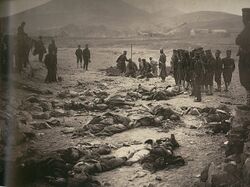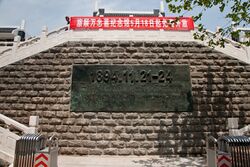
旅顺慘案是一场发生于1894年11月21日甲午战争期间,日本军在大清旅顺的屠杀。此为中国平民继湘军南京屠城后再一次在战时遭大规模劫殺。在日军山地元治师团长的指挥下,第1师团下的伊瀬知好成联队长率领的步兵第2联队,连同河野通好联队长率领的步兵第15联队第3大队等一些部队在旅顺报复性的屠杀军人和平民,据估计被屠杀者达到约2,000人至20,000人。[1]
背景
旅顺位于中国辽东半岛最南端,与威海卫隔海相望,共扼渤海门户,是北洋水师重镇。1894年11月,日军攻陷旅顺,对撤退至市内的清兵连续四天进行掃蕩。掃蕩过程事后經由市内的一间红十字会医院,英国人詹姆斯·艾伦、美国人克里曼、英国法学家胡兰德、英国《泰晤士报》和美国的《纽约世界报》等相继記載報导。[2][3]
依据宗澤亚所著《清日战争》,旅顺大屠殺起因有二:「其一,自日清战争开战以来,日本国内報导日清战事一直是连战连勝、各战大捷、清军不堪一击,誇耀日军所向披靡的战果。可是11月18日旅顺口週边土城子战鬥,日军遭遇到了預想不到的挫折,重创了第一师团长山地将军的自尊心,山地将军因此惱羞成怒。」;「其二,19日双台溝附近,山地师团长接到報告:『我騎兵偵察兵约20名在土城子被清兵俘虜,偵查队长中万德次中尉和隨同士兵,首级被清军砍下并断肢割除睾丸。』还亲眼看到卫生兵担架上,被虐殺后肢体殘缺不全的士兵屍体。清军的野蠻之举再次激起山地復仇的怒火,在日军攻入旅顺口時,下达了『除妇女老幼之外,一律格殺勿论』的命令。在强烈復仇心的驅使下,日军开始瘋狂的報復行动。在街市内搜索发现,逃亡的清兵換裝改扮成当地住民混杂在百姓中间难以辨认,躲藏在民家的清兵继续开枪负隅頑抗。司令部接到報告后隨即下达第二道命令:『凡穿著平民服裝,疑为清兵的青壮年者一律誅殺。』之后旅顺的大街小巷到处是殺人的现场,不论清兵与否皆視为清兵,百姓中老幼妇女也成为虐殺的对象。」[4] 英国船员詹姆斯·艾伦自称随美国货轮哥伦比亚号(Columbia)赴华为正在同日本作战的清军运送军火。在旅顺大屠杀期间,他被困于旅顺口。他的著作《在龙旗下——中日战争目击記》描述了战前他沿途看到日军士兵被虐殺后肢体殘缺不全的屍体。[5]但是该书的真实性遭《字林西報》、Japan Weekly Mail、《士蔑報》質疑,认为他并非目击者,书中的人名、船名都对不上号。[6][7][8]戚其章认为该书雖有錯誤,有关旅顺大屠殺的内容与其他史料吻合。[9] 清兵死者葬于白玉山东麓的安葬崗,今称「万忠墓」。
事件
1894年11月21日,日军攻佔“东亚第一堡壘”的旅顺后,对逃竄到市内各处的清兵进行了四天三夜的掃蕩行动,根据英国《旗幟日報》战地记者维利尔斯的報导,短短四天市内就有两万人遇害,只有埋屍的36名华人倖免于难,而這36人的帽子上还寫著「此人不可殺戮」的标記[10]。在现场的美军觀察者奥布萊恩中尉說,被殺戮的包括俘虜和平民,并且还看到了断肢,但他又說道:「在那种情況下,很多军队都会如此,我们也不能指望在日军身上会发生奇蹟。」当時美国報紙亦跟进報导并描述:「日本为蒙著文明皮膚,具野蠻筋骨之怪兽。」,「日本今天已经摘下了文明的假面具,暴露了野蛮的真面目。」[11]
据《旅大史話》記載,屍体运了一个月才抬完,花溝张家窯堆积两万多具屍体,形成一座屍山。日军下令澆油点火,燒了十几天才燒完。燒成骨灰后,草草裝了四口大棺材,埋在白玉山东麓的安葬崗[12][13]。
记录
英国人詹姆斯·艾伦(James Allan)在他的著作《在龙旗下——中日战争目击記》中寫道:「在我周围都是狂奔的难民。我第一次亲眼看见日本兵追逐逃难的百姓,用枪杆和刺刀对付所有的人,对跌倒的人更是凶狠地乱刺。」[14]日军击毙所有遇见的人,在街道上行走,脚下到处踩着死尸。天已经黑了,「屠杀还在继续进行着,丝亳没有停息的迹象。枪声、呼喊声、尖厉的叫声和呻吟的声音,到处回荡。街道上呈现出一幅可怕的景象:地上浸透了血水,遍地躺卧着肢体残缺的尸体,有些小胡同简直被死尸堵住了,死者大都是城里人。」[15]艾伦又写道:“我站在一处高地,离我不远处有一个池塘,池塘边站着好多日本兵,拼命将一群难民往池塘赶,不一会池塘裡便塞满了人。只见难民在水里乱成一片,池塘边的日本兵,有的拿枪射击,有的用枪上的刺刀刺。池塘裡断头的,斩腰的,穿胸的,破腹的,搅成一团,水变成通红一片。日本兵在一旁欢笑狂喊,快活得不得了。池塘裡少数活人,在死尸上爬来爬去,满身血污。其中一个女人,抱着一个小孩子,浮出水面,朝日本兵发出凄婉的哀求。岸边的日本兵竟拿刺刀来捅,当胸捅了个对穿。第二下又捅那个孩子,只见刺刀一捅,小孩子被捅到刺刀上,他高高的挑起枪来,摇了几摇,当作玩耍的东西。那女人伏在地下,尚未捅死,用奄奄一息的力气,想要起来看看那个孩子,刚挣扎了一下,又趴下了。日本兵就照屠杀别人的方法,也将这个女人斩成几段。”[16]
《纽约世界報》記者詹姆斯·克里曼写道:“我經过各街,到处见屍体均殘毀如野兽所嚙。被殺之店舖生意人,堆积疊在道旁,眼中之淚,傷痕之血,都已冰结成块。甚至有知灵性之犬狗,见主人屍首之僵硬,不禁悲鸣于側,其慘可知矣……”[17]
此事件对日本社会也引起极大反响,《自由新闻》发文称《旅顺陷落的大捷报已化为万钧之雷砸向吾人头顶》,美国驻日公使谭恩对陆奥宗光说:“如果此时日本政府不采取一定的善后措施,那么迄今日本获得的名誉将完全毁掉。”随后,俄国驻日公使希特罗渥亦面晤陆奥,谈及旅顺口屠杀事件时,“虽所言与美国公使略同,然其口气冷淡,令人可怕”。陆奥不敢怠慢,急电伊藤博文说:“此等事实如最终不能否定,应有一定善后之考虑。”[18]之后由陆奥宗光亲自去美国发布声明,大意为所杀的都是脱掉军服的逃跑清军,屠杀是对之前土城子战斗中被杀的日军俘虏的报复行为,在旅顺被俘的清军355人现在在日本受到很良好的对待等。并且收买媒体如中央通讯社,对率先进行报道事件的《时代周刊》进行攻击。之后給各国駐日公使发去辩解书,通知他们说:“关于占领旅顺口之际所发生的事实,因来自误传而毁坏我军之声誉,且使外国人往往怀有不快之感,对我甚为不利。为此而起草了关于上述误传之辩解书。”[19]但隨军采訪的两名西方記者都认同有屠殺发生,一个是《纽约世界報》的克里曼,他的数字是2000平民遇害,[17]另一个報道两万人被殺的维利尔斯則是《伦敦新聞画報》的战地記者。
日兵的证言
日军步兵第2联队第2大队第5中队上等兵加部东常七《日清战役从军手记》记录:“本联队占领黄金山炮台之后,闯入市街在各家各户搜索,昏暗中遇见清人就毫不留情砍杀。小队在街区搜索前进,忽然在民家暗处发现一敌兵,我大喝一声,此人一瞬惊呆,刺刀就深深捅进对方的胸膛,他痛苦地紧紧握住枪剑,我用力拔出刺刀,那紧握枪剑的四指被刀刃割断,身体向一侧倾斜,再补一刺便魂飞魄散。”[20]
消息来源
首先報导大屠殺的是《纽约世界報》記者詹姆斯·克里曼,他報导6万人被屠殺,后来广受批评为誇大煽情[20]。当时旅顺平民只有6,000人,清军在添兵后也只有2万人[21][22],克里尔曼描述日军屠杀的具体死亡数字受到質疑[23][24][25]。
影响

2001年埃尔曼(Elleman)总结道:“由于旅顺屠殺产生了很大的轟动效应,哪怕是以聳人聽聞的方式获得的,卻在各国中产生了同情中国的傾向,這也使得日本放棄了很多苦战得来的东西,特別是遼东半岛。”。[26]
参见
引用
- ↑ 英冒险家记录甲午旅顺大屠杀:女人被斩成几段. 环球网. 2014年4月1日.
- ↑ 袁村平. 觉醒的国殇:甲午战争120年祭. 2014-07-01: 第90頁. ISBN 978-7-210-06382-7.
- ↑ Sir Thomas Erskine Holland. Studies in International Law. Clarendon Press. 1898年: 第116, 118頁.
- ↑ 《清日战争》在线阅读(19). 读书频道_齐鲁网.
- ↑ 在龙旗下,第66-67頁: "The Chinese took some prisoners, whom they slew mercilessly, and one of the first things I saw on the morning of the 19th was a pair of corpses suspended by the feet from the branches of a huge camphor tree near the parade-ground. They were hideously mutilated. They had been disembowelled; the eyes were gouged out, the throat cut, and the right hand severed. They were perfectly naked, and groups of children were pelting them with mud and stones....The bodies of the Japanese soldiers killed in encounters with the enemy as they closed on the place, were often found minus the head or right hand, sometimes both, besides being ferociously gashed and slashed. Corpses were still hanging on the trees when the fortress fell, and it is not surprising that their former comrades should have been maddened by the sight, though of course the officers are greatly to blame for permitting the fearful retaliation which ensued to be carried to such lengths."
- ↑
Under the Dragon Flag. North China Herald. 1898-05-16.
Under the Dragon Flag is very nicely printed, and bound in green cloth with the dragon flag on the cover ; but there are so many inaccuracies and impossibilities in the account, that the author is certainly not relating what he actually saw. His dates do not tally with the facts, which he may perhaps say is so much the worse for the facts ; and when he tells us, as he does on page 30, that from an elevated point on the rocky coast of "the Liaotung" he had, with the aid of powerful glasses, a good view of the battle of the Yalu, he presumes too much on our credulity...
- ↑ Under the Dragon Flag. Japan Weekly Mail. 1898-03-05: 第228, 233頁.
- ↑ Under the Dragon Flag. Japan Weekly Mail. 1898-03-19: 第284, 293頁.轉載《士蔑報》
- ↑ 戚其章. 旅顺大屠殺真相再考. 《东嶽论叢》. No. 第1期. 2001年.
- ↑ Villiers, Frederic. The Truth About Port Arthur. The North American Review. Vol. 160 no. 460 (University of Northern Iowa). 1895年3月: 第330頁. JSTOR 25103490 (英语).
- ↑ 陳悦,西方人眼中的甲午战争,2014-04-20
- ↑ 錢钢. 《大清海军与李鸿章》. 香港: 中华书局. 2004: 第188–190頁. ISBN 978-962-8820-43-6.
- ↑ 董志正. 《旅大史話》. 辽宁人民出版社. 1984: 第109頁.
- ↑ 在龙旗下,第77頁: "There was a rush and hurry of fugitives all around me, and now for the first time I saw the Japanese soldiers in pursuit, pressing on the fleeing throng, and using rifle and bayonet furiously on all and sundry, stabbing and hacking fiendishly at those who fell."
- ↑ 在龙旗下,第83-84頁: "The butchery was proceeding without the least sign of abatement; shots, shouts, shrieks, and groans resounded on every side; the streets presented a fearful spectacle; the ground was saturated with blood, and everywhere strewn with horribly mutilated corpses; some of the narrower avenues were positively choked with carnage. The dead were mostly the townspeople;"
- ↑ 在龙旗下,第79-80頁: "I have said that the land by which I had come out on the lake inclined steeply upwards, and the water was about fifteen feet below me when I arrived in sight of it. It was surrounded by crowds of Japanese soldiers, who had driven large numbers of the fugitives into the water, and were firing on them from every side, and driving back with the bayonet those who attempted to struggle out. The dead floated on the water, which was reddened with blood. The soldiers, yelling and laughing with vengeful glee, seemed to gloat over the agonies of their victims. It was fearful to see those gory forms struggling in the agitated water, those who still lived endeavouring to extricate themselves from the mass of corpses, falling fast, but often rising again with their last energies, streaming with water and blood, and uttering piteous cries and appeals for mercy, which were mocked by the fiends around them. Many women were amongst them; one I noticed carrying a little child, which, struggling forward, she held up to the soldiers as if in appeal. As she reached the bank, one of the wretches struck her through with his bayonet, and with a second stroke as she fell transfixed the child, which might have been two years old, and held its little body aloft. The woman rose and made a wild effort to regain the child, but evidently exhausted and dying, fell back again into the water. Her body—and in fact it was done with every body that came within reach—was hacked in pieces."
- ↑ 17.0 17.1 EXTRA. 2 O'CLOCK. - PORT ARTHUR MASSACRE. Two Thousand Men, Women and Children Butchered in the Streets. CARNIVAL OF SLAUGHTER. Japanese Soldiers Laughed at the Misery of Helpless Children and Women. GEN. OYAMA'S INDIFFERENCE. The Town Sacked from End to End and the Storekeepers Shot and Sabred.. New York World. 1894-12-20: 第1,3頁.
- ↑ 《日本外交文书》第27卷,第941号
- ↑ 《日本外交文书》第27卷,第943、945号
- ↑ 20.0 20.1 Stewart Lone. Japan's First Modern War: Army and Society in the Conflict with China, 1894-5. Palgrave Macmillan UK. 1994-08-30: 第155–156頁. ISBN 978-0-230-38975-5.
- ↑ 在龙旗下,第41页
- ↑ Henry Davenport Northrop. The Flowery Kingdom and the Land of the Mikado Or China, Japan and Corea: Containing Their Complete History Down to the Present Time; Manners, Customs and Peculiarities of the People; Superstitions; Idol Worship; Industries; Natural Scenery, Etc., Etc., Together with a Graphic Account of the War Between China and Japan, Its Causes, Land and Naval Battles, Etc., Etc. Elliott Publishing Company. 1894年: 第582頁.
- ↑ W. Joseph Campbell. Getting It Wrong: Debunking the Greatest Myths in American Journalism. University of California Press. 2016-10-18: 第22–23頁. ISBN 978-0-520-29129-4.
- ↑ The Port Arthur Outrages. New-York Tribune (New York). 1894-12-20: 第6頁 –通过Chronicling America: Historic American Newspapers. Library of Congress.
- ↑ Daniel Kane. Each of Us in His Own Way: Factors Behind Conflicting Accounts of the Massacre at Port Arthur: 第23頁. 10 Jun 2019. doi:10.1080/00947679.2005.12062669.
- ↑ Bruce A. Elleman. Modern Chinese Warfare, 1795-1989. Taylor & Francis. 2001-02-22: 第108頁. ISBN 978-0-203-97691-3.
参考文献
- James Allan. Under the Dragon Flag: My Experiences in the Chino-Japanese War. London: W. Heinemann. 1898年 (英语). 该书中译本为詹姆斯·艾伦. 《在龙旗下——中日战争目击記》. 由费青/费孝通翻译. 上海人民出版社. 2014年. ISBN 978-7-208-12493-6.